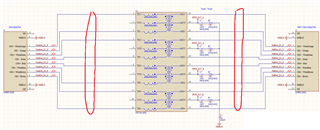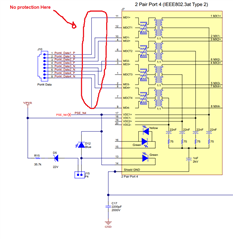Other Parts Discussed in Thread: TPD1E01B04, , ESD401, TPD4E1B06, BOOST-PSEMTHR-007, ESDS304
Hi All,
I'm looking for a ESD and Surge protection (on data lanes) recommendation for 10Gbps PoE PSE Injector ( there is no ETH phy on the device but only magnetics to inject the power)
My configuration is RJ45 (Data Input) -> Magnetics -> RJ45 ( Data output + PoE)
Q1)Do you recommend ESD devices ( TPD1E01B04, TPD4E02B04 or ESD401, TPD4E1B06) on data lanes on the marketed positions in picture below?

Q2) Eg what is the difference between ESD401 and RClamp0524S ( this one can be used between RJ45 and magnetics in PoE as per DS) ? Booth have Reverse stand-off voltage 5V?
Q3)on BOOST-PSEMTHR-007 ( no ESD protection on data lanes) the MDCT pins are no connect why is that so? don't they need decoupling caps and BoB Smith termination? ( Pin 12,6,1,7)

Best Regards,
David.


